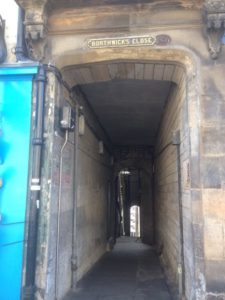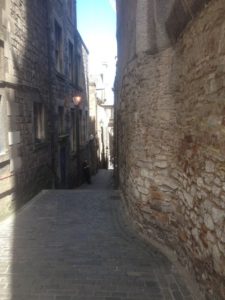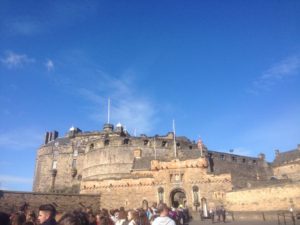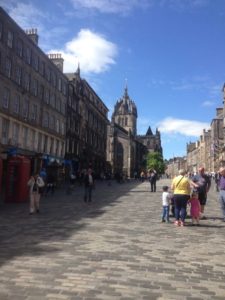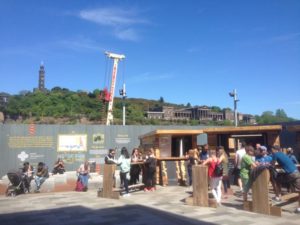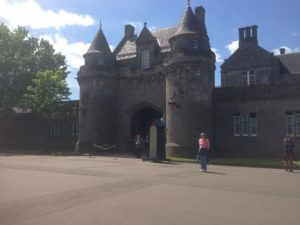Edinburgh (pronounced Edinbura)
We tendered into port (about 25 min) and took a city bus (#10) right across from where the tender dropped us. We had to have the right change, 4 pounds for an all day ticket, but the bus dropped us in front of the Scottish National Gallery at the foot of Castle Rock (literally built on a rock).
We made our way up to the Royal Mile through one of the incredibly old, narrow closes (alleyways).
The Castle didn’t open until 9:45, so we waited in line for about 30 min to be admitted and buy our tickets (13 L for seniors). The castle is built on a rock and has been inhabited since 1000BC and fortified by the Picts in the 3 an 4th centuriessince Roman traded with Pict leaders. The views from the castle are spectacular.
We wandered through St. Margaret’s Chapel built in 1076, the oldest surviving building in Edinburgh.
We saw the Scottish crown jewels and royal chambers before they got crowded.
Afterwards, we wandered down the Royal Mile, stopping at the Writer’s Museum on one of the closes (alley) that snake off the Royal Mile to see rooms dedicated to Sir Walter Scott, Robert Burns, and Robert Lewis Stephenson. A literary walk starts from this point at 1:30 but we didn’t have time to wait.
We stopped in St. Giles Cathedral, really the High Kirk of Edinburgh, Church of Scotland since 1500. The Medieval and Norman original is encased in a Georgian exterior that dates to 1828 but the spire is from 1485. A choir was rehearsing for a concert and we were treated to etherial music surrounded by stunning stained glass windows.
We stopped in the Royal Mile Tavern (wonderful atmosphere with old prints on the walls) and had a reasonable fish and chips lunch with a local Caledonia ale.
We also stopped at the People’s Museum off Tollhouse close, an interesting vision of poverty in the city over the centuries.
From there we made our way down to the Palace of Holyroodhouse, where we found a short line and no crowds (12 L for seniors). The left tower of the palace was built in 1530 by James but rebuilt in a classical style by Charles in 1670’s. The different levels of the interior courtyard facade show ionic, doric and corinthian columns.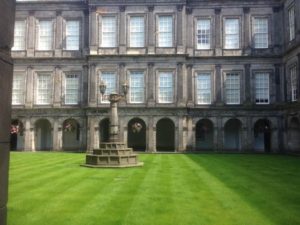
The dining room, first was used by Queen Victoria, who liked to stay here and at her newly purchased Balmoral Castle, and she imported tapestries and furnishings from London to make the palace more comfortable.
Holyroodhouse is the seat of the Stuarts.
The portrait hall displays over 100 portraits commissioned by Charles II to establish his ancestry, many invented by the Dutch artist James De Witt who in 1648 signed a contract to deliver 110 portraits in two years, turning out one every 2 weeks.
Mary Queen of Scots was named queen of Scotland before she was one, but was sent to France at the age of five and raised by her mother’s family. At 15, she married the dauphin, son of the king of France, but he lived only two years and she returned to Scotland a widow. She next married Lord Darnely (20) and gave birth to her son James the VI of Scotland, who later became James I of England, unifying England and Scotland into Great Britain.
Lord Darnley became jealous of Mary’s Italian advisor and he and a group of other men stabbed him over fifty times.
A year later Lord Darnley was killed (it is suspected by Mary’s lover, whom she later married). He and she became unpopular and she was forced to abdicate and fled to England where her cousin, Elizabeth I, imprisoned her and later had her executed for treason.
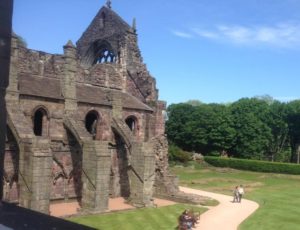 The ruins of Holyrood Abbey (built in 1128 as an Augustinian abbey) are beside the palace. By 1500 it was one of the largest monasteries in Scotland, with a design similar to St. Gyles.
The ruins of Holyrood Abbey (built in 1128 as an Augustinian abbey) are beside the palace. By 1500 it was one of the largest monasteries in Scotland, with a design similar to St. Gyles.
 Arthur’s Seat, an 822 ft rocky mountain covered with yellow furze rises in the middle of Edinburgh.
Arthur’s Seat, an 822 ft rocky mountain covered with yellow furze rises in the middle of Edinburgh.
Across the street from the palace is the new Parliament building (Scotland has its own parliament for the first time in 300 years). The building is a bit of a modern eyesore among so many historic buildings.
From Holyroodehouse, we caught bus 35 to Ocean Terminal, where we got a free shuttle bus back to our tender location.
The temperatures were once again in the 60’s, a heat-wave for this area.




